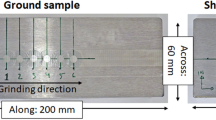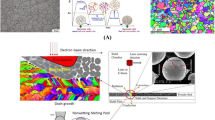Abstract
The boronizing process is a thermochemical surface treatment related to diffusion and requires high temperature and long-period soaking time. The applied direct current is a method that provides extra energy to the boronizing agent, and then the boronizing duration time shall be reduced. Moreover, predictive models of boronizing are recently essential and interesting for manufacturing. Therefore, powder-packed boronizing processes with and without an applied direct current field on AISI 420, 440C, and 304 stainless steels were investigated at 850–950 °C for about 2–6 h. Boride layer thicknesses were measured and predicted using kinetics and machine learning techniques, i.e., deep neural networks and adaptive neuro-fuzzy inference systems. The diffusion rate of boron atoms was enhanced, and the activation energies of powder-packed boronizing processes decreased if the direct current field was involved. The diffusion kinetic, deep neural networks, and adaptive neuro-fuzzy inference systems were efficient predictive tools for the boride layer thickness of powder-packed boronizing processes with and without an applied direct current field. Six input features, i.e., boronizing time, -temperature, Carbon-, Chromium-, Nickel contents, and condition of the direct current field, were used in the deep neural networks and adaptive neuro-fuzzy inference systems. The relative importance of input features was analyzed using the modified Garson’s algorithm. The three most critical input features were the boronizing time, -temperature, and direct current field. Modifying input features from six to four of the adaptive neuro-fuzzy inference systems decreased the complexity of the model but unaffected the predictive performance.




















Similar content being viewed by others
Data availability
The datasets used and analyzed in the research are available from the corresponding author upon reasonable request.
References
Davis JR (1994) Stainless steels. ASM International, Almere
Smith WF (1981) Structure and properties of engineering alloys
Isfahany AN, Saghafian H, Borhani G (2011) The effect of heat treatment on mechanical properties and corrosion behavior of AISI420 martensitic stainless steel. J Alloys Compd 509:3931–3936. https://doi.org/10.1016/j.jallcom.2010.12.174
Davis JR (2002) Surface hardening of steels: understanding the basics. ASM International, Almere
Sinha AK (1991) Boriding (Boronizing). In: ASM International. ASM Handbook, pp 437–447
Martini C, Palombarini G, Poli G, Prandstraller D (2004) Sliding and abrasive wear behaviour of boride coatings. Wear 256:608–613. https://doi.org/10.1016/j.wear.2003.10.003
Er U, Par B (2006) Wear of plowshare components in SAE 950C steel surface hardened by powder boriding. Wear 261:251–255. https://doi.org/10.1016/j.wear.2005.10.003
Sen S, Sen U, Bindal C (2005) An approach to kinetic study of borided steels. Surf Coat Technol 191:274–285. https://doi.org/10.1016/j.surfcoat.2004.03.040
Campos-Silva I, Hernández-Ramirez EJ, Contreras-Hernández A et al (2021) Pulsed-DC powder-pack boriding: growth kinetics of boride layers on an AISI 316 L stainless steel and Inconel 718 superalloy. Surf Coat Technol 421:127404. https://doi.org/10.1016/j.surfcoat.2021.127404
Zhou Z, Xie F, Hu J (2008) A novel powder aluminizing technology assisted by direct current field at low temperatures. Surf Coat Technol 203:23–27. https://doi.org/10.1016/j.surfcoat.2008.07.021
Xie F, Zhu Q, Lu J (2006) Influence of direct current field on powder-pack bonding. In: Solid state phenomena. Trans Tech Publications Ltd, pp 167–172
Xie F, Hu J, Zhou ZH et al (2011) Effects of direct current field on powder pack aluminising. Surf Eng 27:134–138. https://doi.org/10.1179/026708410X12593178265625
Xie F, Sun L, Pan J (2012) Characteristics and mechanisms of accelerating pack boriding by direct current field at low and moderate temperatures. Surf Coat Technol 206:2839–2844. https://doi.org/10.1016/j.surfcoat.2011.12.003
Angkurarach L, Juijerm P (2015) Effects of direct current field on powder-packed boriding process on martensitic stainless steel AISI 420. Arch Metall Mater 57:799–804. https://doi.org/10.2478/v10172-012-0087-3
Kahvecioglu O, Sista V, Eryilmaz OL et al (2011) Ultra-fast boriding of nickel aluminide. Thin Solid Films 520:1575–1581. https://doi.org/10.1016/j.tsf.2011.08.077
Kaouka A, Benarous K (2019) Electrochemical boriding of titanium alloy Ti-6Al-4V. J Mater Res Technol 8:6407–6412. https://doi.org/10.1016/j.jmrt.2019.10.024
Sista V, Kahvecioglu O, Kartal G et al (2013) Evaluation of electrochemical boriding of Inconel 600. Surf Coat Technol 215:452–459. https://doi.org/10.1016/j.surfcoat.2012.08.083
Lecun Y, Bengio Y, Hinton G (2015) Deep learning. Nature 521:436–444. https://doi.org/10.1038/nature14539
Kopper A, Karkare R, Paffenroth RC, Apelian D (2020) Model selection and evaluation for machine learning: deep learning in materials processing. Integr Mater Manuf Innov 9:287–300. https://doi.org/10.1007/s40192-020-00185-1
Ghaboussi J, Pecknold DA, Zhang M, Haj-Ali RM (1998) Autoprogressive training of neural network constitutive models. Int J Numer Methods Eng 42:105–126. https://doi.org/10.1002/(SICI)1097-0207(19980515)42:1%3c105::AID-NME356%3e3.0.CO;2-V
Lee SI, Shin SH, Hwang BC (2021) Application of artificial neural network to the prediction of tensile properties in high-strength low-carbon bainitic steels. Metals Basel 11:1314. https://doi.org/10.3390/met11081314
Lin YC, Zhang J, Zhong J (2008) Application of neural networks to predict the elevated temperature flow behavior of a low alloy steel. Comput Mater Sci 43:752–758. https://doi.org/10.1016/j.commatsci.2008.01.039
Lourenço R, Andrade-Campos A, Georgieva P (2022) The use of machine-learning techniques in material constitutive modelling for metal forming processes. Metals (Basel) 12:427. https://doi.org/10.3390/met12030427
Nguyen DS, Park HS, Lee CM (2020) Optimization of selective laser melting process parameters for Ti–6Al–4V alloy manufacturing using deep learning. J Manuf Process 55:230–235. https://doi.org/10.1016/j.jmapro.2020.04.014
Campos I, Islas M, González E et al (2006) Use of fuzzy logic for modeling the growth of Fe2B boride layers during boronizing. Surf Coat Technol 201:2717–2723. https://doi.org/10.1016/j.surfcoat.2006.05.016
Haghdadi N, Zarei-Hanzaki A, Khalesian AR, Abedi HR (2013) Artificial neural network modeling to predict the hot deformation behavior of an A356 aluminum alloy. Mater Des 49:386–391. https://doi.org/10.1016/j.matdes.2012.12.082
Rao KP, Prasad YKDV (1995) Neural network approach to flow stress evaluation in hot deformation. J Mater Process Tech 53:552–566. https://doi.org/10.1016/0924-0136(94)01744-L
Jang JSR (1993) ANFIS: adaptive-network-based fuzzy inference system. IEEE Trans Syst Man Cybern 23:665–685. https://doi.org/10.1109/21.256541
Suparta W, Alhasa KM (2016) Adaptive neuro-fuzzy interference system BT: modeling of tropospheric delays using ANFIS. In: Suparta W, Alhasa KM (eds) Springer International Publishing, Cham, pp 5–18
Wiriyasaroj T, Juijerm P, Scholtes B, Niendorf T (2019) Fatigue and cyclic deformation behavior of non- and boronized austenitic stainless steel AISI 304 at room and elevated temperatures. Songklanakarin J Sci Technol 41:349–354. https://doi.org/10.14456/sjst-psu.2019.44
Topuz P, Çiçek B, Akar O (2016) Kinetic investigation of AISI 304 stainless steel boronized in indirect heated fluidized bed furnace. J Min Metall Sect B Metall 52:63–68. https://doi.org/10.2298/JMMB150301007T
Kul M, Danacı I, Gezer KB (2020) Effect of boronizing composition on hardness of boronized AISI 1045 steel. Mater Lett 279:128510. https://doi.org/10.1016/j.matlet.2020.128510
Chun MS, Biglou J, Lenard JG, Kim JG (1998) Using neural networks to predict parameters in the hot working of aluminum alloys. J Mater Process Technol 86:245–251. https://doi.org/10.1016/S0924-0136(98)00318-5
Genel K (2004) Application of artificial neural network for predicting strain-life fatigue properties of steels on the basis of tensile tests. Int J Fatigue 26:1027–1035. https://doi.org/10.1016/j.ijfatigue.2004.03.009
Sabokpa O, Zarei-Hanzaki A, Abedi HR, Haghdadi N (2012) Artificial neural network modeling to predict the high temperature flow behavior of an AZ81 magnesium alloy. Mater Des 39:390–396. https://doi.org/10.1016/j.matdes.2012.03.002
Han Y, Qiao G, Sun J, Zou D (2013) A comparative study on constitutive relationship of as-cast 904L austenitic stainless steel during hot deformation based on Arrhenius-type and artificial neural network models. Comput Mater Sci 67:93–103. https://doi.org/10.1016/j.commatsci.2012.07.028
Lin YC, Chen XM (2011) A critical review of experimental results and constitutive descriptions for metals and alloys in hot working. Mater Des 32:1733–1759. https://doi.org/10.1016/j.matdes.2010.11.048
Garson GD (1991) Interpreting neural-network connection weights. AI Expert 6:46–51
Goh ATC (1995) Back-propagation neural networks for modeling complex systems. Artif Intell Eng 9:143–151. https://doi.org/10.1016/0954-1810(94)00011-S
Olden JD, Jackson DA (2002) Illuminating the “black box”: Understanding variable contributions in artificial neural networks. Ecol Modell 154:135–150
Gevrey M, Dimopoulos I, Lek S (2003) Review and comparison of methods to study the contribution of variables in artificial neural network models. Ecol Modell 160:249–264. https://doi.org/10.1016/S0304-3800(02)00257-0
Acknowledgements
The authors sincerely thank the Graduate School of Kasetsart University, Thailand, for financial support for Ms. Laksamee. Angkurarach.
Author information
Authors and Affiliations
Contributions
PJ was involved in conceptualization, supervision, modelling analysis, and writing. LA was involved in conceptualization, experiments and data curation. PN was involved in conceptualization, experiments and data curation.
Corresponding author
Ethics declarations
Conflict of interest
All authors declare that there is no conflict of interest concerning the submission of this manuscript.
Additional information
Handling Editor: Maude Jimenez.
Publisher's Note
Springer Nature remains neutral with regard to jurisdictional claims in published maps and institutional affiliations.
Rights and permissions
Springer Nature or its licensor (e.g. a society or other partner) holds exclusive rights to this article under a publishing agreement with the author(s) or other rightsholder(s); author self-archiving of the accepted manuscript version of this article is solely governed by the terms of such publishing agreement and applicable law.
About this article
Cite this article
Juijerm, P., Angkurarach, L. & Naemchanthara, P. Direct current field enhanced boronizing of stainless steels and predictive performance of diffusion kinetics, deep neural network, and adaptive neuro-fuzzy inference system on boride layer thickness. J Mater Sci 58, 16507–16522 (2023). https://doi.org/10.1007/s10853-023-09072-4
Received:
Accepted:
Published:
Issue Date:
DOI: https://doi.org/10.1007/s10853-023-09072-4




